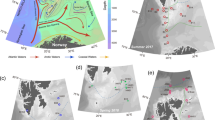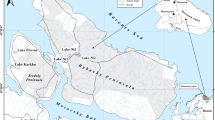Abstract
The nutrient and phytoplankton distributions in the North East Water polynya (NEW) were determined in June 1991. At Norske Øer Ice Barrier (the polynya's southern boundary), water was upwelled, but vertical instability precluded the development of phytoplankton blooms. Along the length of the northward coastal current, part of the anticyclonic circulation in this area, the vertical stability increased to the north by the input of melt water and solar heating. This caused a gradual increase in phytoplankton biomass and a decrease in nutrient concentrations until, in the northernmost area, nitrate was depleted at the surface, and sub-surface maxima of chlorophyll a were observed. The band of high chlorophyll a concentrations extending from this area to the south along the eastern margin of the polynya was interpreted as the presence of phytoplankton advected by the local circulation. The phytoplankton communities, consisting mainly of flagellates and diatoms, were typical for the beginning of phytoplankton development in ice-covered areas. They seemed to be partially released from melting ice. Three communities were distinguished, which represented, firstly, the upwelled water and its northern extension, secondly, an area of high phytoplankton biomass in the northwestern part of the polynya, and thirdly, the pack-ice region. The major taxa co-occurred at all stations, with only their relative importance changed. The nutrient concentrations in the NEW were different from those in the adjacent areas. The low nitrate values of about 4 μM in the upper 70 m, found to be representative for the beginning of the growth season, imposed limitations on the overall phytoplankton production. Therefore, fertilization mechanisms such as upwelling along the Norske Øer Ice Barrier are important for local nutrient replenishment during the period of active phytoplankton growth. Eventually, silicate and phosphate supplied in higher concentrations by jets of the Arctic outflow may also support phytoplankton production, although these nutrients were not limiting during this study. The high-nutrient jets were detected in the upper 100 m of the water column at the eastern boundary of the polynya.
Similar content being viewed by others
References
Barthel KG (1988) Feeding of three Calanus species on different phytoplankton assemblages in the Greenland Sea. Meeresforschung 32:92–106
Bourke RH, Newton JL, Paquette RG, Tunnicliffe MD (1987) Circulation and water masses of the East Greenland Shelf. J Geophys Res 92:6729–6740
Evans CA, O'Reilly JE (1966) A handbook for the measurement of chlorophyll a in netplankton and nanoplankton. National Oceanic and Atmospheric Administration, Highlands, New Jersey
Field JG, Clarke KR, Warwick RM (1982) A practical strategy for analysing multispecies distribution patterns. Mar Ecol Prog Ser 8:37–52
Gascard JC, Kergomard C, Jeannin PF, Fily M (1988) Diagnostic study of the Fram Strait marginal ice zone during summer from 1983 and 1984. Marginal ice zone experiment: Lagrangian observation. J Geophys Res 93:3613–3641
Gradinger RR, Baumann MEM (1991) Distribution of phytoplankton communities in relation to the large-scale hydrographical regime in the Fram Strait. Mar Biol 111:311–321
Gray JS, Aschan M, Carr MR, Clarke KR, Green RH, Pearson TH, Rosenberg R, Warwick RM (1988) Analysis of community attributes of the benthic macrofauna of Frierfjord/Langesundfjord and in a mesocosm experiment. Mar Ecol Prog Ser 46:151–165
Hasle GR (1993) Nomenclatural notes on marine planktonic diatoms. The family Bacillariaceae. Nova Hedwigia Beih 106:315–321
Hirche H-J, Baumann MEM, Kattner G, Gradinger R (1991) Plankton distribution and the impact of copepod grazing on primary production in Fram Strait, Greenland Sea. J Mar Syst 2:477–494
Horner RA (1984) Do the ice algae produce the spring phytoplankton bloom in seasonally ice-covered waters? In: Mann DG (ed) Proceedings of the 7th International Diatom-Symposium, Philadelphia, August 22–27, 1982. Koeltz, Koenigstein, pp 401–409
Horner RA, Schrader GC (1982) Relative contributions of ice algae, phytoplankton and benthic microalgae to primary production in near shore regions of the Beaufort Sea. Arctic 35:485–503
Kattner G (ed) (1992) The expedition ARKTIS VIII/1 of RV “Polarstern” 1991. Ber Polarforsch 113:1–75
Kattner G, Becker H (1991) Nutrients and organic nitrogenous compounds in the marginal ice zone of the Fram Strait. J Mar Syst 2:385–394
Schandelmeier L, Alexander V (1981) An analysis of the influence of ice on spring population structure in the southeast Bering Sea. Limnol Oceanogr 26:935–943
Schneider W, Budéus G (1994) The North East Water polynya (Greenland Sea). I. A physical concept of its generation. Polar Biol 14:1–9
Smith SD, Muench RD, Pease CH (1990) Polynyas and leads: an overview of physical processes and environment. J Geophys Res 95:9461–9479
Spies A (1987) Phytoplankton in the marginal ice zone of the Greenland Sea during summer, 1984. Mar Biol 7:195–205
Spies A, Brockmann UH, Kattner G (1988) Nutrient regimes in the marginal ice zone of the Greenland Sea in summer. Mar Ecol Prog Ser 47:195–204
Stirling I (1980) The biological importance of polynyas in the Canadian Arctic. Arctic 33:303–315
Strickland JD, Parsons TR (1972) A practical handbook of seawater analysis. Fisheries Research Board of Canada, Ottawa
Syvertsen EE (1991) Ice algae in the Barents Sea: types of assemblages, origin, fate and role in the ice-edge phytoplankton bloom. Polar Res 10:277–287
Tunnicliffe MD (1985) An investigation of the waters of the East Greenland Current. Master's thesis, 136 pp, Naval Postgrad. Sch., Monterey, Calif
Utermöhl (1958) Zur Vervollkommnung der quantitativen Phytoplanktonmethodik. Mitt Int Ver Theor Angew Eimnol 9:1–38
Wadhams P (1981) The ice cover in the Greenland and Norwegian Seas. Rev Geophys Space Phys 19:345–393
World Meteorological Organisation (1985) WMO sea ice nomenclature. WMO Rep Tech Pap 145 [Suppl 4]
Author information
Authors and Affiliations
Rights and permissions
About this article
Cite this article
Lara, R.J., Kattner, G., Tillmann, U. et al. The North East Water polynya (Greenland Sea). Polar Biol 14, 483–490 (1994). https://doi.org/10.1007/BF00239053
Received:
Accepted:
Issue Date:
DOI: https://doi.org/10.1007/BF00239053




